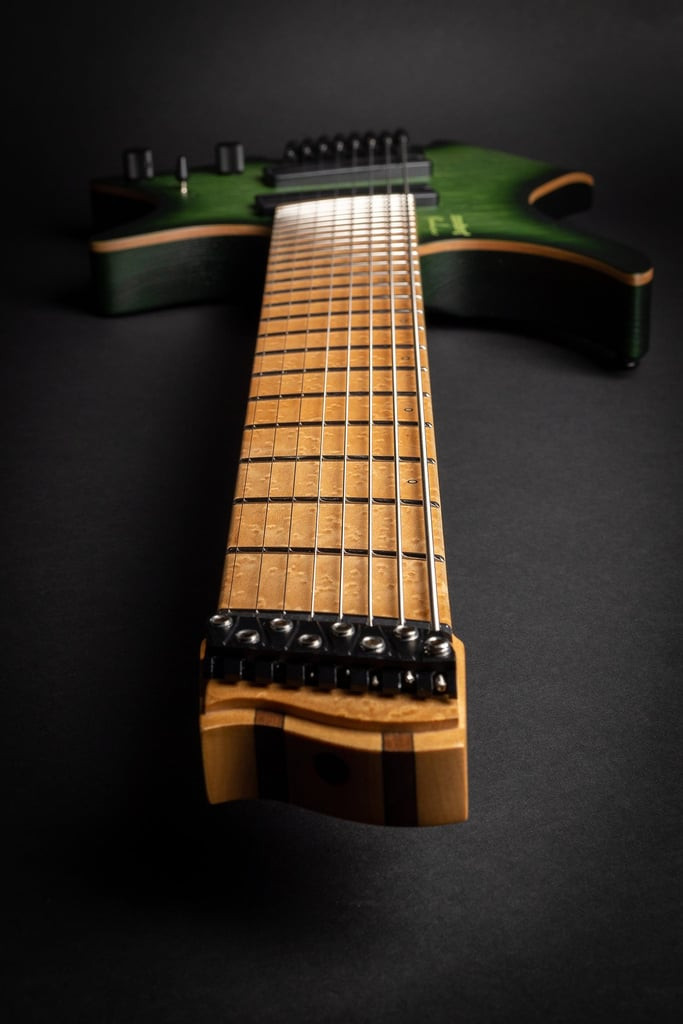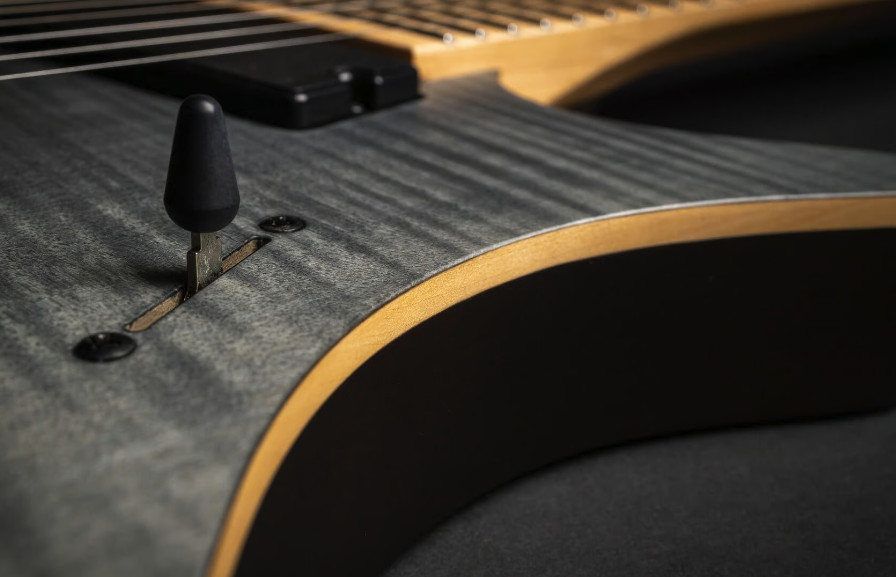Extended range guitars, especially 7 and 8 string models, open up a world of sonic possibilities for guitarists. While the options for tuning these instruments are vast, certain configurations have become standards due to their practicality and versatility. This guide, brought to you by guitarplayers.net, will delve into the most common Seven String Guitar Tunings, exploring their benefits, challenges, and applications across various musical genres.
You will discover:
- Popular 7-string guitar tunings
- Advantages of expanding to a 7-string guitar
- Potential hurdles when adopting a 7-string
- How .strandberg* guitars enhance the 7-string experience
- Insights from .strandberg* artists on 7-string guitars
- Resources for further learning and support
 Strandberg Boden Prog NX 7 string headless guitar in Twilight Purple, showcasing its ergonomic design and extended range capabilities.
Strandberg Boden Prog NX 7 string headless guitar in Twilight Purple, showcasing its ergonomic design and extended range capabilities.
Diving into 7-String Guitar Tunings
Focusing primarily on extended-range guitars, we will concentrate on the three most prevalent tunings for 7-string guitars. We’ll also touch upon their typical usage in different musical styles and genres to help you find the perfect fit for your musical aspirations.
Standard 7-String Tuning: B-E-A-D-G-B-E
The bedrock of seven-string guitar tunings is undoubtedly Standard Tuning. It elegantly extends the familiar six-string standard tuning (E-A-D-G-B-E) by adding a lower B string. This addition grants access to five extra notes below the low E on a standard six-string, all without altering the fingerboard layout or pitch of the original six strings.
This makes Standard 7-string tuning exceptionally popular across a spectrum of musical styles, especially heavier genres like metal where the extended low range adds significant depth and power. However, its versatility also appeals to musicians in diverse genres who require a broader tonal palette without constant tuning changes or instrument swaps.
For guitarists transitioning to a 7-string, Standard Tuning is an ideal starting point. It maintains the core note layout that is already ingrained, while seamlessly introducing the expanded lower register. Familiar chord shapes and scale patterns largely remain intact, smoothing the learning curve and accelerating adaptation.
Drop A 7-String Tuning: A-E-A-D-G-B-E
Drop A tuning takes the standard 7-string tuning a step further by lowering the lowest B string a whole step down to A. This mirrors the popular Drop D tuning on a 6-string guitar, a configuration that has been a staple in rock and metal for decades. Drop A enhances the lower register even more and simplifies playing power chords on the lowest strings with single-finger barres.
The expanded low end and the ease of power chords in Drop A have fueled its surge in popularity, particularly in modern metal subgenres.
.strandberg* artist Connor Kaminski favors Drop A tuning, noting:
“You still get your regular six-string guitar layout, but gain access to incredibly easy power chords and drop chord shapes. This accessibility is incredibly useful.”
All Fourths 7-String Tuning: B-E-A-D-G-C-F
All Fourths tuning shifts the paradigm by focusing on consistent intervals rather than direct pitch comparisons to standard tuning. While it can be implemented at various starting pitches, in the context of 7-string guitars, it’s often presented as a variation of standard tuning. Unlike standard tuning’s major third interval between the G and B strings, All Fourths tuning establishes perfect fourth intervals between all adjacent strings.
This creates a uniform and symmetrical intervallic relationship across the entire fretboard. Some players find this uniformity simplifies fretboard navigation, making complex chords and scales more intuitively accessible and visually consistent across the neck.
 Strandberg Boden Original NX 8 string headless guitar in Earth Green, highlighting the extended fretboard and headless design optimized for ergonomic playing.
Strandberg Boden Original NX 8 string headless guitar in Earth Green, highlighting the extended fretboard and headless design optimized for ergonomic playing.
Tunings Across Genres: 7-String Guitar Versatility
While extended-range guitars have found homes in numerous genres, they are particularly prominent in jazz, various metal subgenres, and even classical guitar.
In metal and rock, the pursuit of sonic heaviness often dictates tuning choices. Consequently, Standard and Drop A tunings are frequently favored for 7-string guitars in these genres, offering the desired low-end power and aggressive tonality.
Jazz musicians who embrace extended-range guitars typically prefer standard tuning for both 7 and 8 string instruments. Progressive rock players also often gravitate towards standard tuning, valuing the broader range while maintaining familiar musical theory frameworks. Ultimately, however, tuning selection is a deeply personal choice. The “best” tuning is the one that ignites your creativity and maximizes your enjoyment of playing.
 Screenshot showcasing various guitar tabs and musical notations, representing the diverse applications of 7 and 8 string guitars across genres.
Screenshot showcasing various guitar tabs and musical notations, representing the diverse applications of 7 and 8 string guitars across genres.
Why Choose a 7-String Guitar? Expanding Your Sonic Horizon
For a more in-depth exploration of this topic, refer to our comprehensive article here. However, for a concise overview, continue reading.
The motivations for switching to a 7-string guitar are as diverse as guitarists themselves. Musical influences often play a significant role in this decision. Consider Simon Girard of Beyond Creation, whose journey to 7 and then 8-string guitars was sparked by hearing Beneath the Massacre. Or Connor Kaminski, who embraced the 7-string after being inspired by Dream Theater.
Beyond individual inspiration, there are compelling, objective advantages to transitioning from a 6-string to a 7-string guitar:
- Expanded Tonal Range: Unlocking lower frequencies for heavier riffs and richer harmonies.
- Enhanced Note Accessibility: Wider note selection within each fretboard position, reducing hand shifting.
- New Musical Territories: Opening doors to genres and techniques that thrive on extended range capabilities.
1. Greater Tonal Range: Unleashing Low-End Power
A 7-string guitar empowers musicians with a significantly wider tonal range, a powerful asset for both composition and performance. While not every musical passage demands the lowest notes, having them readily available is akin to a pianist’s expansive keyboard – it unlocks vast creative possibilities.
2. Easier Access to Notes Across the Fretboard
The additional string on a 7-string guitar means that any given fretboard position offers access to a broader spectrum of notes. This reduces the need for extensive hand stretching when playing complex chords or intricate melodic lines, promoting fluidity and ease of playing.
3. Exploring New Musical Ground: Venturing into Progressive Soundscapes
7-string guitars are indispensable tools for many progressive music genres. They are fundamental in crafting intricate riffs, complex chord voicings, and the sonic landscapes characteristic of progressive metal, djent, and other forward-thinking styles. For musicians eager to explore uncharted musical territories, the 7-string guitar is a vital instrument.
 Screenshot of a hand playing a Strandberg guitar, demonstrating comfortable reach and ergonomic design for complex 7-string chord shapes.
Screenshot of a hand playing a Strandberg guitar, demonstrating comfortable reach and ergonomic design for complex 7-string chord shapes.
Navigating the Challenges of 7-String Guitars
While the rewards of playing a 7-string guitar are substantial, it’s important to acknowledge the initial challenges. Many players perceive a learning curve when transitioning to extended-range instruments. However, with dedicated practice and adaptation, these hurdles are readily overcome. Understanding these potential challenges allows for proactive preparation and a smoother transition.
- Ergonomic and Physical Adjustments: Adapting to a wider neck and string spacing.
- Technical Adaptations: Refining techniques for the expanded fretboard and string count.
- Equipment and Sonic Integration: Optimizing gear and tone for the extended frequency range.
1. Ergonomic and Physical Adjustments: Embracing the Wider Neck
7-string guitar necks are naturally wider than those of 6-string guitars to accommodate the additional string. This necessitates slightly more hand strength and a refined technique to navigate the increased width of the neck and fretboard effectively. The larger instrument size can initially feel more physically demanding, particularly during extended playing sessions or when tackling complex musical passages.
2. Technical Adaptations: Mastering the Expanded Fretboard
The expanded fretboard and additional strings inherently introduce greater complexity in fretboard navigation. Mastering the new note layout and effectively utilizing the extended range requires focused practice. Picking, strumming, and sweeping techniques may also need adjustments to accommodate the extra string and wider string spacing for optimal articulation and clarity.
3. Equipment and Sonic Integration: Taming the Extended Frequencies
The wider tonal range of a 7-string guitar presents unique sonic considerations in composition and tone shaping, particularly when integrating with other instruments in a mix. Composing with fewer low-frequency limitations demands careful attention to arrangement to avoid muddiness or frequency clashes. Similarly, your existing guitar signal chain might require adjustments to faithfully reproduce and amplify the extended range without losing clarity or definition.
 Screenshot of audio mixing interface, illustrating the need for careful sonic integration when using extended range guitars in music production.
Screenshot of audio mixing interface, illustrating the need for careful sonic integration when using extended range guitars in music production.
.strandberg* 7-String Guitars: Designed for Enhanced Playability
Beyond the inherent advantages of 7-string guitars, .strandberg instruments offer unique benefits specifically tailored to enhance the playing experience and address common challenges associated with extended-range guitars. These features are consistently praised by the .strandberg community for promoting ergonomics and maximizing playing enjoyment.
- Optimized Center of Gravity: Balanced weight distribution for reduced strain.
- Patented EndurNeck™ Profile: Ergonomic neck shape for enhanced comfort and technique.
- Lightweight Construction: Reduced physical burden for longer playing sessions.
Different Center of Gravity: Achieving Optimal Balance
A defining characteristic of .strandberg* headless guitars is their balanced weight distribution, a departure from conventional electric guitars with headstocks. Headless designs typically achieve a more uniform weight distribution across the instrument’s body, creating a sense of equilibrium. This balance significantly reduces physical strain, particularly during prolonged playing sessions, and is especially advantageous for players who prefer a lighter, more centered feel.
Patented EndurNeck™ Profile: Ergonomics Redefined
The .strandberg* patented EndurNeck™ profile is meticulously engineered to provide both exceptional comfort and support to your forearm and wrist. This unique neck shape promotes proper hand posture, allowing you to play for extended periods without fatigue and facilitating improved technique. The EndurNeck™ empowers you to focus entirely on your playing and musical expression, free from physical limitations.
Lighter Weight: Reducing Physical Strain
In addition to their headless design, .strandberg* guitars are typically significantly lighter than traditional electric guitars. This weight reduction stems from both the absence of a headstock and the innovative materials and construction techniques employed. Lighter guitars offer tangible benefits, including increased mobility on stage and reduced stress on the shoulders and back, particularly valuable during long practice sessions or performances.
Artist Perspectives: 7-String Insights from .strandberg* Players
Many acclaimed artists have chosen 7-string .strandberg* guitars as their instruments of choice. Through conversations with these musicians, we’ve gathered valuable insights into the transition from 6-string to 7-string guitars and their experiences with extended range instruments.
Below are thoughts and tips from Simon Girard, frontman and guitarist of Beyond Creation, Charlie Griffiths, guitarist for Haken, and Connor Kaminski, a prominent social media guitar phenomenon.
 Simon Girard of Beyond Creation, sharing his experience transitioning to 7-string and 8-string guitars and the expanded musical possibilities they offer.
Simon Girard of Beyond Creation, sharing his experience transitioning to 7-string and 8-string guitars and the expanded musical possibilities they offer.
Simon Girard’s Thoughts on Making the Switch:
– “I was playing 6-string and then I listened to Beneath the Massacre, who play seven strings. So I bought a seven string and I went crazy, the possibilities were endless. And then one year later, I was like “why didn’t I buy an eight string? Why didn’t I go further so I could have that very low end sound?” The transition to go from six to seven strings was not hard. And then moving from seven to eight felt natural. It’s was a good transition.”
 Connor Kaminski demonstrating 7-string guitar techniques and explaining the benefits of Drop A tuning for easy power chords.
Connor Kaminski demonstrating 7-string guitar techniques and explaining the benefits of Drop A tuning for easy power chords.
Connor Kaminski on 7 Strings and Tuning:
– “If you have a seven string guitar, drop your seventh string from a B, which is its standard tuning, down to an A. You still get your regular six string guitar layout, but gain access to incredibly easy power chords, and drop chord shapes. This accessibility is incredibly helpful. As for learning, my biggest recommendation is to learn songs that are played with seven or eight string guitars.”
 Charlie Griffiths of Haken offering tips on adapting to extended range guitars and overcoming the initial visual complexity of the fretboard.
Charlie Griffiths of Haken offering tips on adapting to extended range guitars and overcoming the initial visual complexity of the fretboard.
Charlie Griffiths’ Tips for Extended Range Guitarists:
– “The transition takes a couple of weeks. It can be visually confusing at first. It’s all about how you think of fret boards in small chunks instead of a big road map. As soon as you get used to applying the small chunks of information to your extra strings, it becomes easier. And for the fanned frets, you’d think it would be weird but that’s the least problematic thing. When you play you don’t even see them.”
Explore Further Resources for 7-String Guitar Mastery
To facilitate your journey with 7-string guitars, be sure to explore the additional articles and resources we’ve curated.
In “Why You Should Get a 7- or 8- String Guitar” we delve deeper into the compelling reasons to embrace extended range instruments.
Our comprehensive guide on adjusting intonation from our support team provides detailed instructions and essential knowledge for maintaining optimal intonation on your .strandberg* guitar.
In “The Artistry of Extended Range” discover inspiring performances and playthroughs by three .strandberg* artists showcasing the expressive potential of 7 and 8 string guitars.
And, for a deeper dive into multiscale technology, explore our article on multiscale guitars, although it’s slightly older, it contains valuable insights into strings and scales: Check it out here.
Finding Your Ideal 7-String Tuning
We trust that this guide has illuminated the landscape of 7-string guitar tunings. Remember, while established tunings provide excellent starting points, the ultimate tuning is the one that resonates with your musical vision and enhances your playing experience. Experimentation is key. Explore online resources, and most importantly, dedicate time to trying out different tunings and playing extensively to discover your personal preference.
Happy playing!
If you’re interested in exploring .strandberg* multiscale guitars, browse our full selection of [7 string models](https://strandbergguitars.com/product-category/eu(guitar/7-string-guitar/) and 8 string models to find your perfect instrument.

